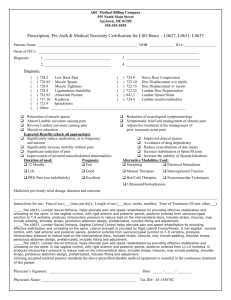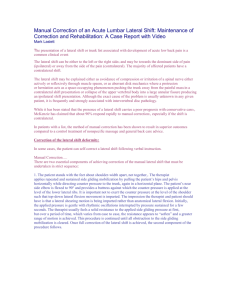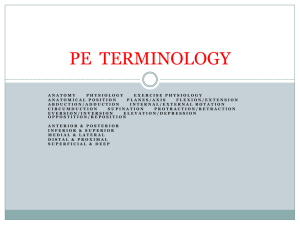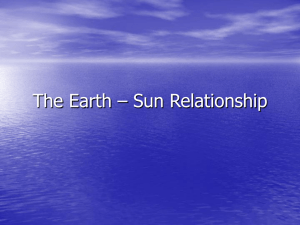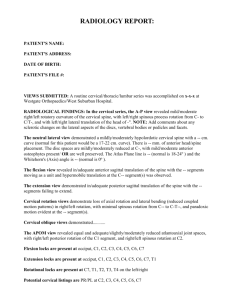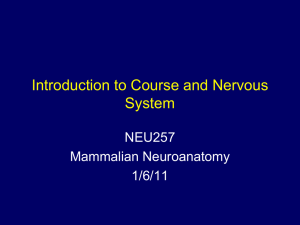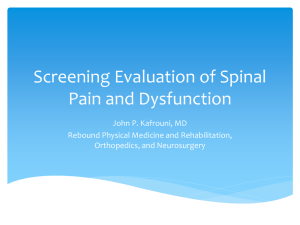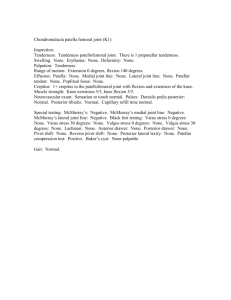Biomechanics of the intervertebral joints
advertisement
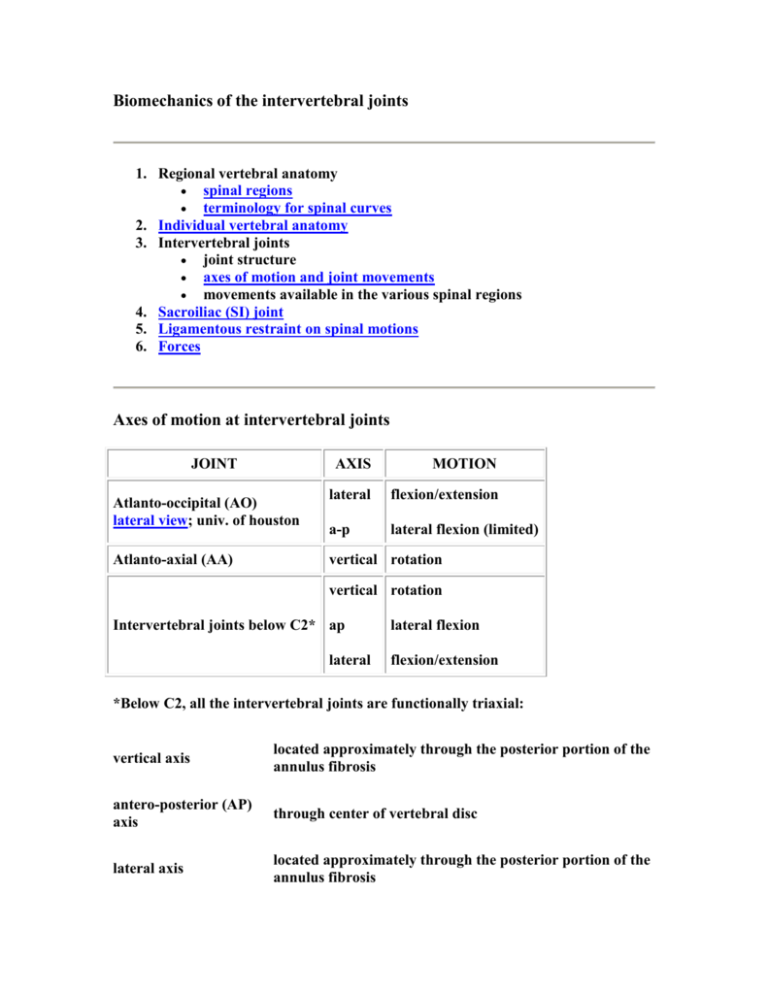
Biomechanics of the intervertebral joints 1. Regional vertebral anatomy spinal regions terminology for spinal curves 2. Individual vertebral anatomy 3. Intervertebral joints joint structure axes of motion and joint movements movements available in the various spinal regions 4. Sacroiliac (SI) joint 5. Ligamentous restraint on spinal motions 6. Forces Axes of motion at intervertebral joints JOINT Atlanto-occipital (AO) lateral view; univ. of houston Atlanto-axial (AA) AXIS MOTION lateral flexion/extension a-p lateral flexion (limited) vertical rotation vertical rotation Intervertebral joints below C2* ap lateral lateral flexion flexion/extension *Below C2, all the intervertebral joints are functionally triaxial: vertical axis located approximately through the posterior portion of the annulus fibrosis antero-posterior (AP) axis through center of vertebral disc lateral axis located approximately through the posterior portion of the annulus fibrosis Pelvic motion requires motion at the surrounding joints When a person stands, with both lower limbs fixed on a surface, pelvic motion requires hip motion. If the shoulders remain fixed as well, pelvic motion requires lumbar motion. These relationships occur in three planes. SAGITTAL LUMBAR FLEXION LUMBAR EXTENSION DECREASED LUMBAR LORDOSIS INCREASED LUMBAR LORDOSIS POSTERIOR PELVIC TILT ANTERIOR PELVIC TILT HIP EXTENSION HIP FLEXION IF PELVIS IS LOW ON LEFT, HIGH ON RIGHT: FRONTAL RIGHT INTERVERTEBRAL LATERAL FLEXION (SIDEBENDING) RIGHT HIP JOINT ADDUCTION LEFT HIP JOINT ABDUCTION TRANSVERSE LEFT FORWARD PELVIC ROTATION =LEFTWARD LUMBAR ROTATION COMPLEMENTARY HIP ROTATION SACROILIAC (SI) JOINT PLANAR JOINT WITH COMPLEX CONTOURED JOINT SURFACE. MOTIONS INCLUDE: SACRAL TORSIONS INNOMINATE ROTATIONS ANTERIOR INNOMINATE ROTATION POSTERIOR INNOMINATE ROTATION Ligaments restrain intervertebral motion Smith, Weiss, and Lehmkuhl (1996, Fig.11-2, p.371) diagram these ligaments' locations. Anterior spinal ligaments (those located anterior to the spine's lateral or flexionextension axis) elongate with and, therefore, limit extension: Anterior longitudinal ligament (1) Posterior spinal ligaments (those located posterior to the spine's lateral or flexionextension axis) elongate with and, therefore, limit flexion: Posterior longitudinal lig. (2) Ligamentum flavum (3) Interspinous lig.(4) Supraspinous lig.(5) Ligamentum nuchae (an elaboration of the supraspinous ligament in the cervical region) Intertransverse lig.* (6) Facet (zygapophysial) joint capsules (7) *Because of their lateral location, intertransverse ligaments (6) limit sidebending to the opposite side, around the intervertebral joint's A-P axis. Posterior ligamentous structures that are extrinsic to the spine also elongate with and prevent flexion: thoracolumbar fascia FORCES PRODUCE MOVEMENT IN THE SPINE Forces can be gravitational or muscular 1. in sagittal plane (around lateral axis) Anterior forces cause flexion Posterior forces cause extension 2. in frontal plane (around a-p axis) Forces to left of axis cause left sidebending. Forces to right of axis cause right sidebending. 3. in transverse plane (around vertical / longitudinal axis) Any force that is not parallel to the spine will cause rotation. References: Smith, L.K., Weiss, E.L., & Lehmkuhl, L.D. (1996). Brunnstrom's clinical kinesiology (5th ed.). Philadelphia: F.A. Davis. Last updated 10-17-01 ©Dave Thompson PT return to PHTH/OCTH 7143 lecture schedule
